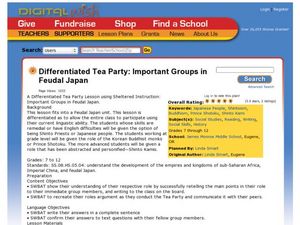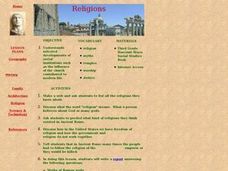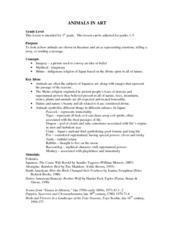Curated OER
Differentiated Tea Party: Important Groups in Feudal Japan
Students research the different groups in Feudal Japan. In this Japanese people instructional activity, students are broken into different groups representing the different roles in Japan. They research their group and have a "tea party"...
Curated OER
Shinto, Stones, and the Garden
Young scholars examine how Shinto and Buddhism are reflected in the Japanese art and life-style, especially as seen in the relationship people have with the land (gardens). This activity is for the elementary classroom.
Curated OER
Lesson: Creating With A Purpose
Discovering the creative process can be done through critical analysis. Upper graders examine a hand -carved Shinto Deity, discussing purpose, technique, and artistic expression. They then read a poem about the creative process. and...
Curated OER
Japanese Religion (Shinto)
Fifth graders explore the relationship between the early Japanese religion of Shinto and the natural phenomena of Japan. They engage in Day 3 of the Warlords of Japan simulation.
Curated OER
Shinto, Japan's First Religion
Students participate in centers activities that enrich understanding of Japanese culture, history, geography, art, and religion.
Curated OER
Feudal Japan and the Samurai
Students study the similarities of Feudal Japan and Europe. They show the feudal society of Japan, recognize the role of the samurai and identify the code of bushido.
Curated OER
Shinto: The Way Of The Gods
Young scholars research and analyze the roots of Shinto in this lesson about Japanese cultural practices and philosophy. Possible lesson enrichments and/or extensions are included with the lesson.
Curated OER
Lesson Plan On Japan
Students participate in a lesson about the Japanese religion of Shinto. This is done using internet research where students compare this to other world religions in the context of the four basic Shinto beliefs.
Curated OER
Religions of Japan
Students explore, analyze and study the religions that originated in Japan, including Shintoism and Zen Buddhism. They assess the beliefs of each religion and compare/contrast all the Eastern Religions and view their people and...
Curated OER
History of Japan
Students research the mythological and factual founding of early Japan. They compare and contrast the two accounts. As an assessment activity, they fill out a chart that compares and contrasts the facts and myths surrounding Japanese...
Curated OER
Fujiyama
Young scholars examine and discuss Mt. Fuji (Fujiyama) and its effect on the culture and philosophy of Japan. This high school lesson is ideal for a Social Studies, Humanities, or Asian Studies class.
Curated OER
Integrating Anime and Manga into an Art of Motion Picture Course
Students examine the art of Anime and note its characteristics. Using scenes, they identify the plots, characters and themes trying to be portrayed. In groups, they compare and contrast the animation in America to that of Anime and...
Curated OER
Religion And Magic
Students examine the indigenous religions of China (Daoism) and Japan (Shinto) to see how magical beliefs and practices form an integral part of these religions. This lesson may be controversial.
Curated OER
Nature and Haiku Poetry
Young scholars compose haiku poems and recognize how cultures value nature and
natural forces through the study of Japanese poetry. This lesson includes a bibliography of resources.
Curated OER
One With Nature
Students discover the connection between Japanese art and Romantic literature using a variety of sources and the impact of nature on these two art forms. This lesson is a three-day exploration.
Curated OER
Haniwa
Students use non-fired clay and posterboards to create and display examples of Haniwa and kofun in this exciting lesson for the Social Studies, Humanities, Asian Studies, or Art classroom.
Curated OER
The Four Religions of East Asia
Students compare and contrast the four main religions of Asia (Buddhism
Confucianism, Daoism, and Shinto). This lesson plan is intended for use in the middle school Social Studies classroom.
Curated OER
The Tale of the Mandarin Ducks
Students are introduced to the time of the samurai warriors using the guided reading of "The Tale of the Mandarin Ducks". The teacher reads the story to the students and they make connections from the text about the history of the samurai.
Curated OER
Religions
Eighth graders explore the major religions of the world. In this religion lesson, 8th graders create a foldable with the characteristics of the religions to study. Students watch videos, PowerPoint slides and look at pictures from the...
Curated OER
The Golden Rule of Reciprocity: A Silk Road Encounters Project
Learners are introduced to the Golden Rule of Reciprocity. Using the four major world religions, they compare and contrast quotes about the Golden Rule. In groups, they create their own version of the Rule and share it with the class.
Curated OER
Comparative religious Teachings
Ninth graders examine the goods and culture that was traded along the Silk Road. In this World History lesson, 9th graders compare and contrast the belief systems of the Silk Roads. Students analyze a primary text of sacred and...
Curated OER
The Golden Rule of Reciprocity
Students explore The Golden Rule of Reciprocity from various religions. In this religious beliefs activity, students examine various religious quotes and summarize the idea of The Golden Rule in a sentence.
Curated OER
Animals in Art
Students look at how animals are shown in literature and art as representing emotions, telling a story, or sending a message in this elementary school Language Arts and Visual Arts lesson.
Curated OER
The Language of Flowers And Trees
Students explore the symbolism of flowers and trees in Chinese and Japanese art. This lesson meets state standards and includes two possible lesson extensions or lesson enrichments.

























